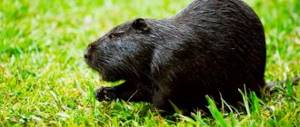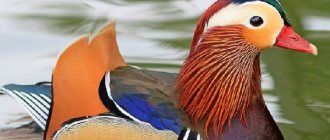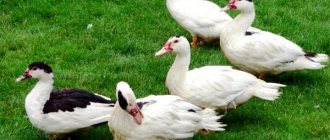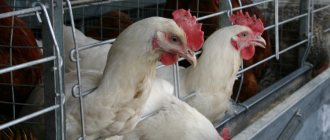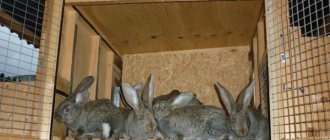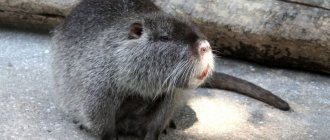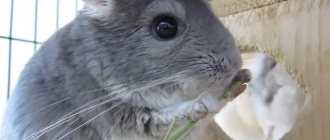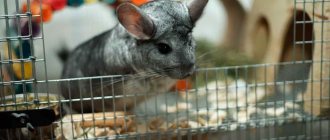Which cells are suitable for nutria: basic requirements
In terms of their behavior in captivity, nutria are very similar to rabbits, with the only difference being that in summer weather the first thing to do is organize a swimming pool or carry out regular water procedures.
When arranging housing for animals, it is necessary to take into account two important factors:
- nutria lifestyle;
- climate conditions in the animal breeding region.
- In addition, the future design must meet several requirements:
- the building must be made of durable materials, such as metal, since rodents can easily damage the structure with their teeth;
- It is recommended to make the cage walls from fine-mesh steel mesh. This will ensure free access of oxygen to the animals and allow the farmer to easily monitor the pets;
- the dwelling must provide for the possibility of insulation for the winter. In addition, it is advisable to make a collapsible structure that can be disassembled and moved to another location;
- the building must have a swimming pool, which is required for water procedures;
- the house must have a place for feeding and a nesting compartment;
- drinkers and feeders must be firmly fixed.
When organizing a home for animals, you need to remember that nutria can be kept as a family, up to five individuals, with one male and four females. It is not recommended to place more than one male in one cage, since males do not get along well with each other.
To summarize, it should be noted that houses for nutria should be warm, spacious, durable, with a walk and a swimming pool.
Keeping nutria in the summer
Keeping nutria in summer is fundamentally different from the more difficult winter period.
In the warm season, animals can be released for walking, having first fencing it and arranging an artificial pond so that the rodents will feel like they are in the wild.
And while they are walking, it will not be difficult for you to clean the cages. The main thing is to make sure that there are houses where you can hide from bad weather or hot sun rays.
Sow - features and characteristics of selection and rules for keeping a sow (photo + video)Domestic pig - features of keeping and breeding pigs, recommendations for feeding and care
- Sheep clipper - the main tool for harvesting wool, selection rules and characteristics of the tool
Types and features
When choosing the type of housing structure for nutria, farmers primarily focus on the weather conditions of the region. In warm climates, animal enclosures can be located outside. But in colder climates, it is advisable to build portable structures that are placed outside in the summer and moved to a warm room in the winter.
For summer maintenance
A special feature of cages for the summer habitat of animals is that they do not require insulation. For the construction of structures, you can use brick, metal, steel lattice. In hot weather, animals must have constant access to water - for this purpose, homes are equipped with an artificial pool or pond.
1 - swimming pool; 2 — descent; 3 - walking; 4 - house.
If it is not possible to install water containers inside the cage, they are placed in the walking area. An excellent alternative to a swimming pool is a shower, which farmers can organize for the animals themselves, up to 3 times a week.
Important! In the northern regions, the nights are quite cold, so experts recommend keeping nutria indoors throughout the year.
Summer enclosures
The most convenient and comfortable housing option for nutria in the summer are considered to be enclosures, which provide the animals with a large area for walking and walking. In order to separate animals, for example, young animals or pregnant females, it is necessary to equip several enclosures at the same time.
As a rule, concrete is used as a material for constructing the base of a structure, which ensures high strength and durability of the structure. The walls are made of steel mesh, sheets of plywood or slate. For convenience and insulation of the home, the floor is covered with bedding material.
On the area of the enclosure there are houses in which pets can hide in hot or rainy weather.
Permanent cells
In regions with warm climatic conditions, above-ground stationary houses made of brick or natural stone are used to organize housing. The walking area is fenced with a steel mesh firmly installed in a concrete base or ground.
Permanent cages are equipped with houses, which must have an opening roof. This design will allow you to easily clean the inside of your home, monitor rodents, and, if necessary, move them from one compartment to another.
Did you know? Nutria are very clean.
They do not have a characteristic specific odor that is characteristic of other rodents.
Cell location
Cages with nutria in such a barn can be arranged in three tiers. For example, in the two lower ones with dimensions of 1x0.8x0.70 m, keep animals in groups. And on the upper tier there are cages in which animals are kept one at a time, the size of such cages is 0.50x0.8x0.5 m.
Project of two-tier arrangement of cells
The tiers must be separated by metal pallets, which are located at an angle. That is, it is very convenient. The manure will fall onto the pallets. Then throw it out of them through a hatch or onto a cart and then take it out. Usually, during the winter, the manure has time to rot and it makes an excellent fertilizer for the garden.
Possible options
Before you start building enclosures for nutria yourself, you should read the description of the most common and popular housing options.
Ground building
The most optimal solution to the housing problem for the nutria family is considered to be a ground-based building, which includes a house (nesting site), a walking area, and a swimming pool. To build such an enclosure, you can use brick, concrete, stone, and blocks.
1 - walking; 2 - door; 3 - house.
The back wall, which serves to limit the reservoir, can be made of metal mesh. Wood can be used to construct the roof, but the inside should be covered with a steel mesh or lattice.
Check out
Nutria farm: DIY construction, drawings, arrangement rules
Stationary sizes for ground-based buildings, provided that there are 5 adult individuals or 6-8 young nutria in it, are considered to be:
- length - at least 1 m;
- width - about 0.8 m;
- facade height - 0.7 m;
- rear wall height - up to 0.5 m.
To preserve heat in winter, the ground building is divided into two chambers: nesting and feeding. If the weather becomes cool, the walking hole is closed, thus retaining heat inside the structure.
Wooden portable house
Portable houses for nutria to live in are made of high-strength, reliable wood. The housing has two compartments, the first of which is intended for feeding the animals, the second for their habitat. The enclosure is made of steel mesh, which is buried 30 cm into the soil to prevent rodents from escaping. In warm weather, the houses are placed outside; in cool weather, they are moved to a more insulated place.
1 - rack for hanging paddocks; 2 - nesting compartment of the house with a mesh floor and a removable upper hatch; 3 — aft compartment with a solid floor; 4 - house pipe.
Structure combined with a barn
In the absence of a large territory for nutria to inhabit, it is advisable to use a structure combined with a barn or any other outbuilding as their housing. In this case, a hole is made in one of the walls of the barn, allowing the animals to go out for a walk.
At the same time, the area for walking is fenced with a steel mesh, and a container with water for swimming is installed there. In winter, the hole leading to the street is tightly closed.
Nutria nutrition
Keeping nutria at home is quite simple, since the animals are “vegetarians”. The nutria menu is varied. You can feed your charges any plant food:
- vegetables - beets, carrots, cabbage, pumpkin;
- grass (mainly clover and alfalfa);
- grain - wheat, millet corn (it should be in the diet as often as possible);
- leftover food - cereals, bread, etc.;
- cleaning;
- young reeds (if there is a body of water nearby);
- grape shoots;
- twigs after pruning bushes and trees.
Usually, nutria are given raw foods, only potatoes are steamed. In this case, the animals will naturally gain weight, the meat will become lean and tasty, and the skin will become pleasantly shiny.
But you can also feed them boiled food. Then the animals will gain weight much faster, but the meat will be fatty and not as tasty. The quality of the fur will also deteriorate.
Step-by-step instructions for making it yourself
As noted above, making a cage with your own hands is not difficult, but before starting work you should make drawings or a diagram of the future structure, prepare the required materials and tools.
Drawings and dimensions
Before starting to build the cage, it is recommended to determine the dimensions of the structure and make preliminary drawings. Detailed housing plans can be found on the Internet. One of the simplest is the design, which is made according to the following drawings:
1 - house; 2 - floor mesh; 3 - wooden frame; 4 — floor of the aft compartment; 5 - pool (trough); 6 — rear removable grille; 7 - roof over the paddock and pool; 8 - door; 9—grid; 10 — removable cover; 11 - side grille.
Tools and materials
In the process of making housing for nutria, you need to prepare the following materials:
- small diameter steel pipes - 5 m;
- concrete pipes - 4 pieces;
- metal mesh, 5-6 mm thick;
- slate or strong boards for the roof;
- cement - 1 bag;
- sand - 1 bag;
- plywood sheets - 1 piece;
- galvanized metal sheet - 1 piece.
Did you know? When they first arrived in South America and discovered nutria there, the Spaniards mistook them for ordinary otters. Translated from Spanish, the word “nutria” means “otter”.
Tools you will need:
- hammer;
- Bulgarian;
- nails for fixing elements;
- screwdriver, drill;
- welding machine with electrodes.
Video: what materials to make a nutria cage from
Frame preparation
The cell construction process begins with the preparation of the frame.
To do this you need:
- Prepare a drawing of the frame, taking into account all the smallest details.
- Make a frame from boards installed in vertical and horizontal directions. You should take 16 boards, 2 boards on each side.
- Make depressions in the soil, 1 m deep, place concrete pipes in them, and fill them with cement-sand mortar. Wait for the solution to harden.
Mesh installation
After the frame is built, the mesh is installed:
- Weld metal pipes to the supports, lay a mesh on them and secure them by welding. To make the structure more stable, weld several diagonals.
- Using screws, attach the frame to the metal structure.
- Install the mesh inside the cage, secure it with wire cutters and a welding machine. Make and attach doors.
Plywood layer
The cage is sheathed using sheets of plywood:
- Cut the plywood into three parts according to the dimensions of the walls of the structure - two side parts and one back wall. Attach the sheets tightly to the walls.
- Cover the plywood sheets with foam plastic on top, then with a sheet of galvanized metal. Such measures will make it possible to insulate housing and provide animals with comfortable living conditions during the winter season.
Important! Instead of galvanized steel, you can
make the top skin using another layer of plywood.
Ceiling
The next stage in making a home for nutria is installing the ceiling:
- The roof is made of steel mesh and secured with a welding machine.
- Cover the ceiling with sheets of slate, plywood, and secure with self-tapping screws.
To simplify the process of caring for the cage, you can make an opening roof.
Nest
The future design of the house must be equipped with a nest.
The sleeping place is performed as follows:
- Make a nesting site on three sides from boards or plywood.
- Cover the fourth side, which leads to the adjacent compartment, with a metal mesh.
- Make a hole in the mesh, measuring 20x20 cm.
It should be noted that the sleeping compartment for animals should not have windows.
Important! In order for rodents to have the opportunity to move freely around the cage, it is necessary
to install doors and manholes for them.
Drinker and feeder
Housing for nutria is equipped with feeders and drinking bowls, which must be as durable and reliable as possible. It is advisable to use metal gutters as “kitchen” utensils. To save space, they are installed along one of the walls.
Pull-out tray
A retractable tray must be made under the mesh cage, which serves for quick and convenient collection of feces. To make the pallet, a durable material is used that does not deform, does not “fall apart” and does not crack under the influence of nutria waste products.
Left: a - manger; b - container covered with mesh; c - drinking bowl-feeder; g - clay feeder; d - retractable feeder. On the right is a nod drinker: 1 - steel tube, 2 - rubber hose, 3 - guide bracket (a, b - manufacturing sequence), 4 - washer, 5 - dowel, 6 - pipe.
Which is better: a cage or an aviary?
Every novice breeder faces the question: which option is better, in cages or in enclosures? The answer to this question is clear - enclosures. Cages are installed only if there is no space for an aviary.
But why is that? Primarily because of the comfort of the nutria themselves. The enclosure will be more spacious and interesting for them. It is more convenient to organize a pool for swamp beavers in the enclosure and provide them with everything they need. For example, in a cage, unlike an enclosure, it is not always possible to install a “pond”, and this is an important condition for a comfortable life for nutria.
But in terms of practicality, the enclosure is significantly inferior. Both nutria cages and enclosures can be installed both indoors and outdoors. But if in the summer it is not difficult to take the cages out into the fresh air, then with an aviary the situation is a little different. It’s simply not possible to take it entirely outside. Keeping nutria in an outdoor enclosure in winter will also not work.
And an important point is animal care. Keeping them in cages is more troublesome. They are inconvenient to clean, especially in hard-to-reach places. The enclosure is spacious enough so that this process does not cause much trouble.
The presence of a reservoir in the enclosure can be considered both its advantage and disadvantage. This is definitely a plus when it comes to nutria leisure time. They love water, they love to swim in it, drink and just wallow. But the disadvantage, if you think from a human perspective: this reservoir needs to be constantly cleaned and the purity of the water monitored.
You can buy an enclosure for nutria, or you can make it yourself. Many breeders believe that building a home for nutria with their own hands is much more convenient. This way you will make a truly reliable design that will meet all your requirements. In addition, building an enclosure for swamp beavers yourself will cost much less.
What we need:
- Wooden slats 50x50mm;
- Plywood;
- Insulation 40mm (foam plastic or polystyrene foam);
- Metal mesh made of wire from 3 mm;
- Slate;
- Galvanization;
- Floor mesh (cells no larger than 0.8mm);
- Door curtains;
- Nails and screws.
Tools needed:
- Roulette;
- Pencil;
- Construction corner;
- Drill;
- Phillips screwdriver;
- Metal scissors (nippers)
- Wood hacksaw;
- Hammer.
How to choose the right cage when purchasing
When choosing a ready-made cage for nutria, you should carefully evaluate all its pros and cons.
In addition, you need to take into account:
- climate conditions under which the structure will be operated;
- number of rodents that will be kept.
The cage should not be cramped, otherwise fights will occur between the animals, which have a detrimental effect on the productivity of nutria, their health, and the quality of meat and skin. An excellent option are portable models, which not only make it possible to move houses from outdoors to indoors or vice versa, but also allow structures to be transported over long distances.
Did you know? In terms of durability and quality, nutria fur is not inferior to fox and mink fur. Nutria skin has the highest quality in the cold season.
How to make a shed for nutria?
The barn shed is one of the most popular bunk cage designs. Inside the room in such a barn there is a longitudinal corridor, on the sides of which houses for nutria are placed in 2 rows. The floor mark of the lower tier is at a height of 70–80 cm.
The dimensions of the house located below are 160x80x50 cm. It is intended for raising 7 nutria per slaughter or for mating a group (1 male for 6 females).
The second tier of the shed-barn has more compact dimensions: the houses are made 80 cm in length, 80 in width and 50 in height. Pregnant females and newborns who have not yet been weaned are usually kept here.
The shed barn has other design features that novice breeders need to take into account:
- The roof of the barn is made of glazed frames.
- Outside, there are 2 paddocks with ponds, access to which is provided by two manholes measuring 24x20 cm. In the cold season, these manholes can be closed with valves to prevent the penetration of cold.
- Each house is divided by a vertical partition into a compartment for food and a nest.
Important! The two- and three-tier design of the houses, in comparison with the use of single-tier cages, significantly simplifies the care of nutria, does not affect the cost of the entire structure and significantly increases the capacity of the room. Moreover, this method of breeding does not have a negative impact on the quality of nutria meat or skins.
Growing nutria is a low-cost and hassle-free activity. These animals are very hardy, not susceptible to disease, and survive well in both hot and cold climates. Nevertheless, successful cultivation requires the creation of favorable conditions, the main one of which is the proper arrangement of the place of detention.
